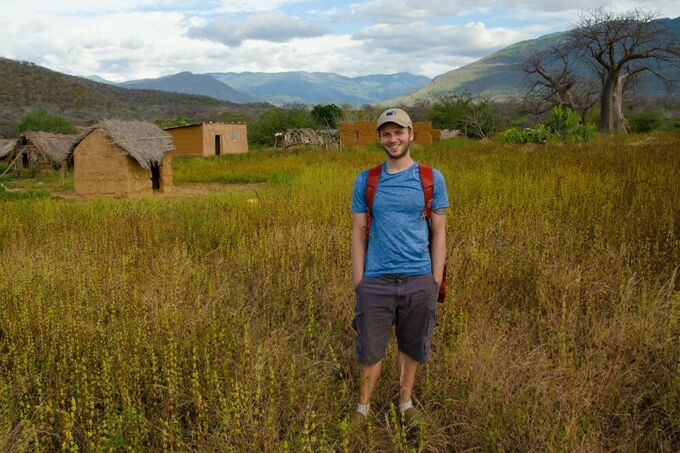February 28, 2018
Students achieve personal, professional growth through study abroad in Tanzania

Man in blue shirt and grey shorts standing in front of grass-thatched huts with the mountains of Tanzania towering in the background.
Andrew Patterson, a geography major, never thought he would be able to study abroad. “When I was a sophomore,” Patterson said, “I switched majors from environmental systems engineering to geography, and so I really didn’t think I would have the ability to study abroad and also graduate in four years.”
In the fall of 2016, Patterson received an email from his adviser, Jodi Vender, containing information about a summer study abroad program in Tanzania.
“After looking at my schedule, it was the perfect fit for me,” Patterson said.
The program, called Parks and People: Conservation of Nature in Community, is a Penn State study abroad service learning and research program that allows students to study the relationship between local communities and their environment. Although Patterson’s program was located at the Udzungwa Mountains National Park in the small village of Mang’ula, Tanzania, Penn State students also can attend the Parks and People program at the Dwesa-Cwebe Nature Reserve in the Eastern Cape province of South Africa.
Article by Emily Morrison Originally published on Penn State News
“When you study abroad and immerse yourself in another culture, you get to learn a lot about other people. But you also get the opportunity to learn more about yourself, too.” – Corey Crews-Williams, energy engineering student
The Mang’ula trip also includes an introductory lecture series at the University of Dar es Salaam, located on the eastern coast of Tanzania, and at Sokoine University of Agriculture, located in south-central Tanzania near Udzungwa. Faculty leaders of the program are Larry Gorenflo, professor of landscape architecture and geography, and Carter Hunt, assistant professor of recreation, park and tourism management, and anthropology. Gorenflo and Hunt direct the student research conducted on the trip and act as liaisons between the students and local researchers. “Carter and I both had similar study abroad experiences when we were undergraduates,” Gorenflo said, “and it changed the way we see the world. We wanted to provide Penn State students to experience the natural and cultural diversity that affected us so profoundly, and to learn that other places and the people who inhabit them are, in many ways, to be embraced and admired. I think the coursework may be secondary in importance to the personal growth that all students seem to experience as they expand their worlds.” A unique feature of the program is that it incorporates students from a variety of colleges and majors. Penn State students from the College of the Liberal Arts, College of Arts and Architecture, Donald P. Bellisario College of Communications, College of Agricultural Sciences, College of Earth and Mineral Sciences, and College of Health and Human Development participate in Parks and People. Through the program’s research component, students choose a project to complete, giving them a chance to explore new topics within their respective fields. Patterson decided to study the ways in which park resource management affects the local subsistence farming community. For him, the Parks and People program helped him gain valuable insight into future opportunities. “I learned that there are a lot of nonprofits that aim to help communities utilize their natural resources effectively,” he said. “My research in Mang’ula really helped me discover that this type of work is what I’d like to pursue as a career.” Hunter Mitchell, a junior majoring in geography, also was inspired by his summer experience in Tanzania. Mitchell’s project involved analyzing both structure sustainability and the cost effectiveness of local construction methods. Essentially, he studied the ways in which new or altered construction materials could make local structures more durable and require less maintenance. “It was a great way to experience what a real-world research environment is like,” Mitchell said. “We all may have been working on our own projects, but we learned teamwork through sharing space and resources.” In fact, Mitchell has returned to Africa for the spring 2018 semester to participate in the Parks and People program in South Africa's Eastern Cape. Corey Crews-Williams, a junior energy engineering major, studied the cost effectiveness of different forms of energy production in Mang’ula. He, like Mitchell, found the social aspect of field research rewarding. “We weren’t just looking at the best technical solutions to certain problems like you might do in a classroom. We were out in the field and working together with locals to try to account for what would ultimately be best for the community,” Crews-Williams said. At the end of the six-week program, the students presented their results at the park’s research center. “That was really special,” Patterson said. “The village chief, the warden of the national park, and all of the people who worked with us were there to see our presentations.” The students enjoyed small trips throughout the course of the program as well, including a safari and trips to local beaches and communities. “When you study abroad and immerse yourself in another culture,” Crews-Williams said, “you get to learn a lot about other people. But you also get the opportunity to learn more about yourself, too.”Article by Emily Morrison Originally published on Penn State News
